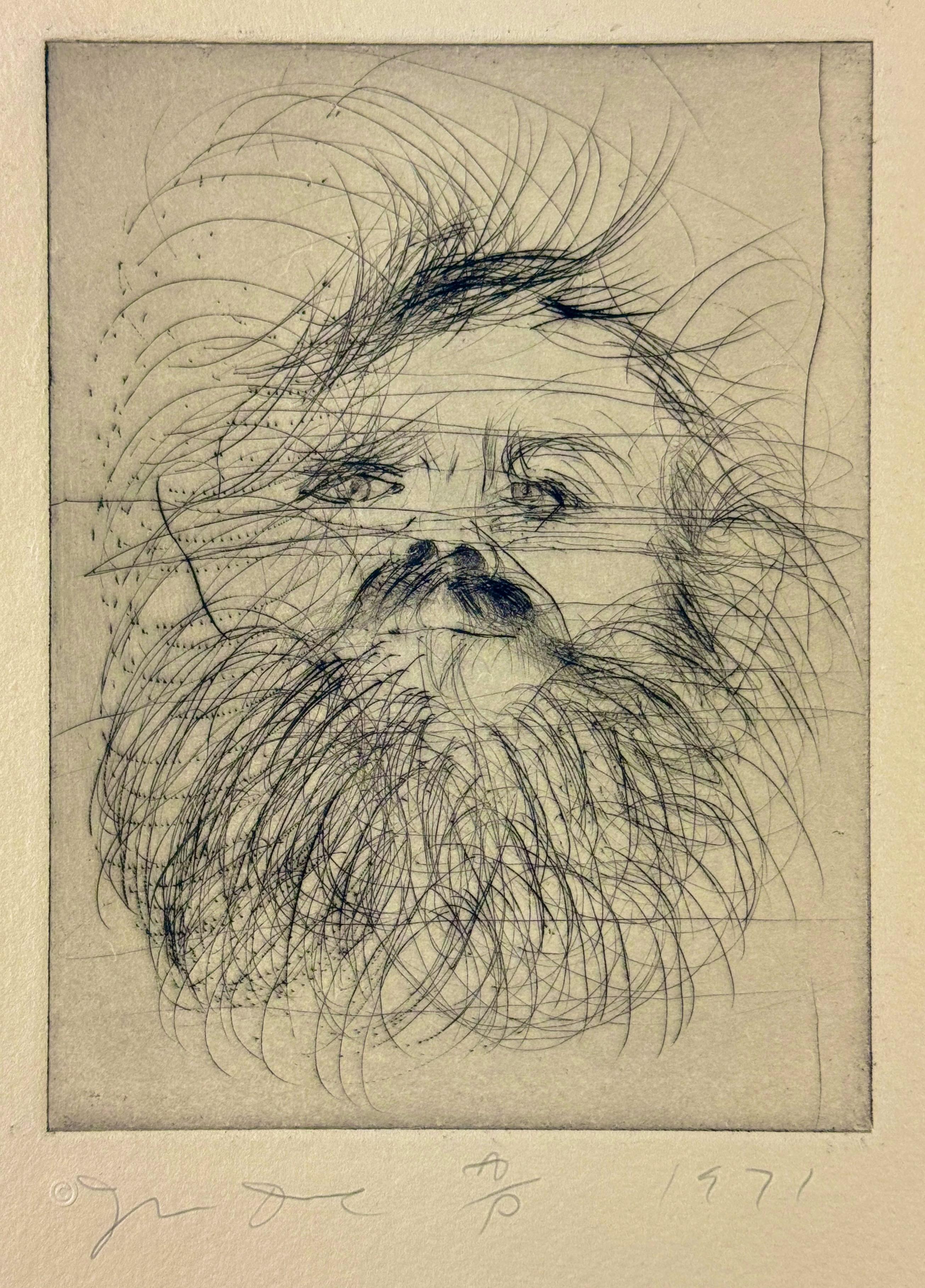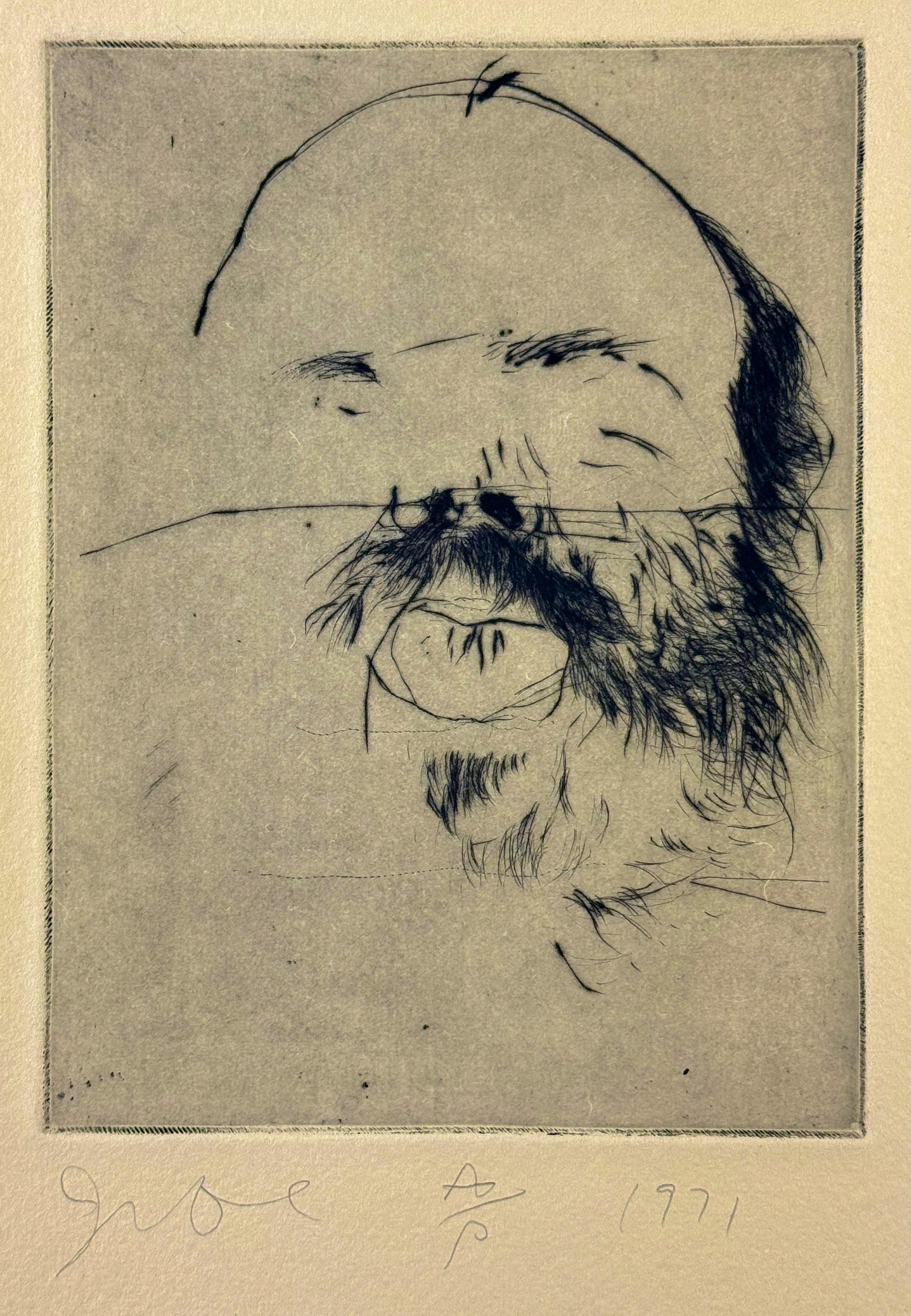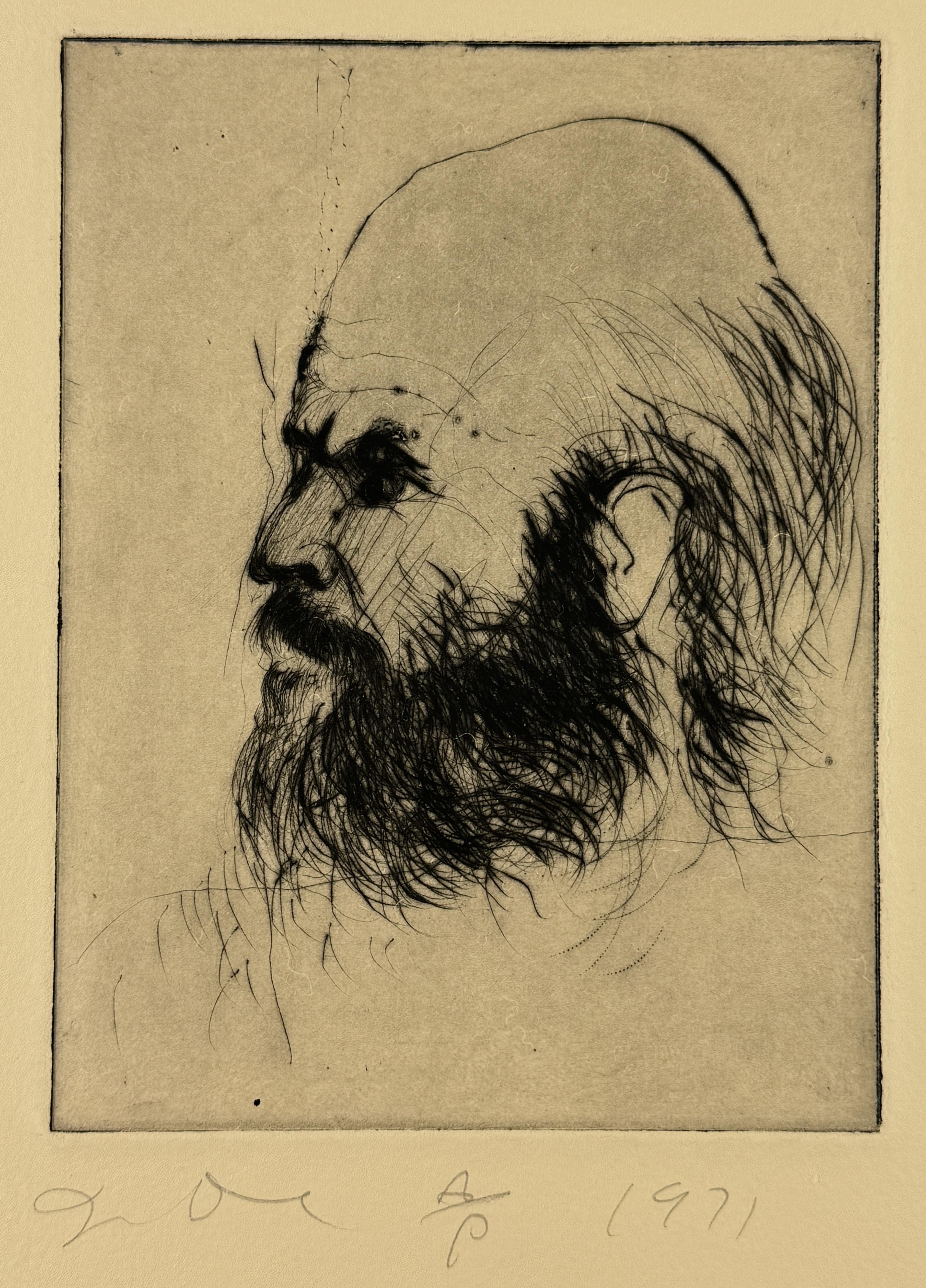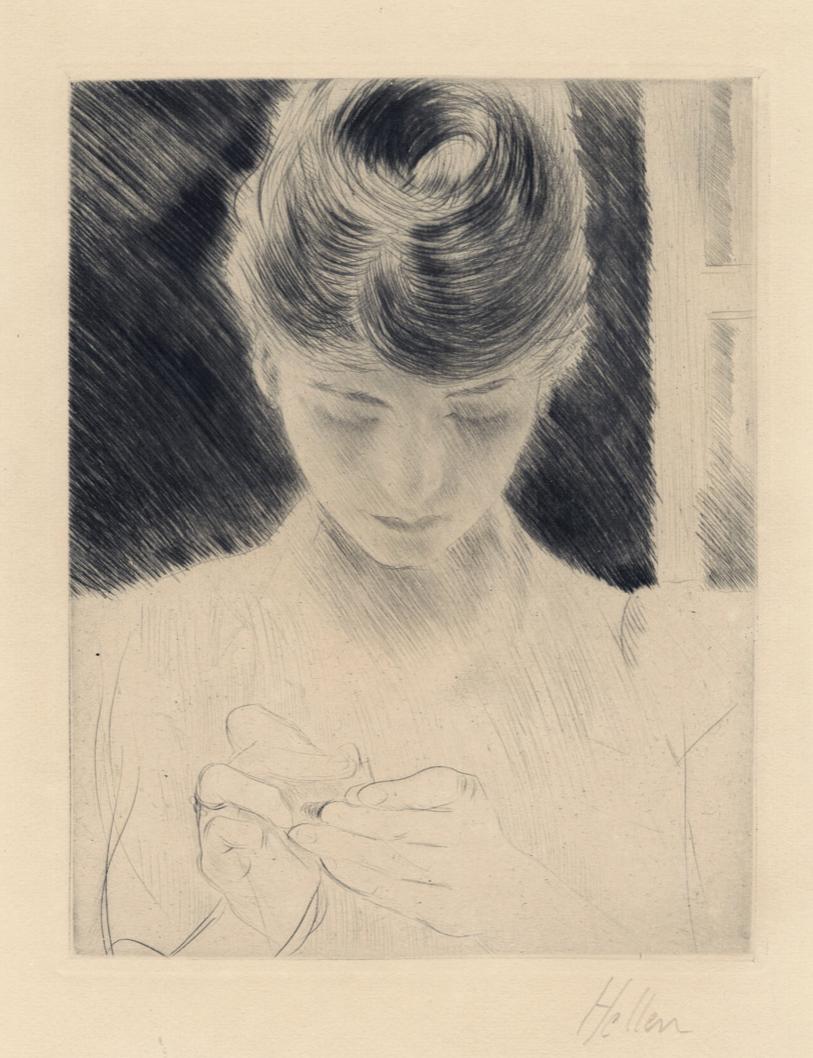Items Similar to Untitled (Portrait)
Want more images or videos?
Request additional images or videos from the seller
1 of 5
William H. BaileyUntitled (Portrait)1974
1974
About the Item
Untitled (Portrait)
Drypoint printed in blue-black graphite mixed with silver, 1974
Signed and dated lower ight (see photo)
From: Series entitled Six Drypoints
Edition: 23 (4/23)
Numbered lower left (see photo)
Print Shop: Crown Point Press
Printer: Jeannie Fine
Publisher: Parasol Press, New York
Note: A portfolio is in the collection of the National Gallery, Australia, Fine Arts Museums of San Francisco- de Young/Legion of Honor, Davis Museum at Wellesley College and the Yale University Art Gallery.
Condition: Excellent
Image/Plate size: 6 3/8 x 5 3/8 inches
Sheet size: 24 x 20 inches
From a portfolio of six drypoints, printed with unqiue combination of blue-black graphite shavings combined with silver to create the appearence of an original drawing. I know of no other artist to use a similar printing technique.
William Bailey studied art at the University of Kansas, Yale University and Yale School of Art where he studied with Josef Albers receiving his MFA in 1957.
Mr. Bailey’s first exhibition in New York was at Robert Schoelkopf Gallery in 1968, where he showed regularly until its closing in 1990. During the 90’s he exhibited at the Andre Emmerich Gallery and on its closing, exhibited at the Robert Miller Gallery. In 2004 Bailey moved to the Betty Cuningham Gallery where his most recent exhibition was held from April 30 - June 11, 2016.
Mr. Bailey’s work has been exhibited extensively in both America and Europe. He is represented in the collections of The Whitney Museum of American Art, The Museum of Modern Art, the Pennsylvania Academy of Fine Arts, and the Hirschhorn Museum and Sculpture Garden, among others. He was awarded a Guggenheim Fellowship in painting in 1965. Mr. Bailey was elected to The National Academy of Design in 1983 and to The American Academy of Arts and Letters in 1986.
Mr. Bailey taught at The Yale School of Art from 1958 to 1962 and from 1969 to 1995. He has also taught at The Cooper Union, University of Pennsylvania and Indiana University. He maintains studios in New Haven and in Umbertide, Italy.
Courtesy Betty Cunningham Gallery
Tribute to William Bailey
THE NEW YORK TIMES
William Bailey, whose pristine, idealized still lifes and female nudes made him one of the leading figures in the return of figurative art in the 1980s, died on April 13 at his home in Branford, Conn. He was 89.
His death was confirmed by his daughter, Alix Bailey.
Beyond his painting, Mr. Bailey influenced generations of students in his many years as a teacher at the Yale School of Art.
In some of his best-known work, Mr. Bailey arranged simple objects — the eggs, bowls, bottles and vases that he once called “my repertory company” — along a severe horizontal shelf, or on a plain table, swathing them in a breathless, deceptively serene atmosphere heavy with mystery.
William Bailey, Modernist Figurative Painter, Dies at 89
He swathed his nudes and still lifes of eggs, vases, bottles and bowls in a breathless, deceptively serene atmosphere heavy with mystery.
The painter William Bailey in 2009. He was never given a career survey in a major museum, but his influence, particulary on students at Yale, was deep.
Ford Bailey
By William Grimes for the New York Times
April 18, 2020
William Bailey, whose pristine, idealized still lifes and female nudes made him one of the leading figures in the return of figurative art in the 1980s, died on April 13 at his home in Branford, Conn. He was 89.
His death was confirmed by his daughter, Alix Bailey.
Beyond his painting, Mr. Bailey influenced generations of students in his many years as a teacher at the Yale School of Art.
In some of his best-known work, Mr. Bailey arranged simple objects — the eggs, bowls, bottles and vases that he once called “my repertory company” — along a severe horizontal shelf, or on a plain table, swathing them in a breathless, deceptively serene atmosphere heavy with mystery.
His muted ochres, grays and powdery blues conjured up a still, timeless world inhabited by Platonic forms, recognizable but uncanny, in part because he painted from imagination rather than life.
“They are at once vividly real and objects in dream, and it is the poetry of this double life that elevates all this humble crockery to the realm of pictorial romance,” Hilton Kramer wrote in The New York Times in 1979.
Mr. Bailey’s female figures, some clothed in a simple shift or robe and others partly or entirely nude, are disconcertingly impassive, implacable and unreadable, fleshly presences breathing an otherworldly air.
The critic Mark Stevens, writing in Newsweek in 1982, credited Mr. Bailey with helping to “restore representational art to a position of consequence in modern painting.”
But his version of representation was entirely idiosyncratic, seemingly traditional but in fact “a modernism so contrarian,” the artist Alexi Worth wrote in a catalog essay for the
William Harrison Bailey was born on Nov. 17, 1930, in Council Bluffs, Iowa. His father, Willard, worked in radio advertising and moved the family from city to city in the Midwest. Bill was in his early teens when his father died. His mother, Marjorie (Cheyney) Bailey, was a homemaker who later worked as an accountant for her second husband, Fred Baker, who ran a business training investigators.
A revival of interest in figurative painting in the early 1980s propelled Mr. Bailey to the cover of Newsweek, which chose his seminude “Portrait of S” to epitomize the trend. Shocked retailers across the country pulled the magazine from their shelves.
Mr. Bailey studied art at the University of Kansas but left before graduating and enlisted in the Army. He saw combat as a platoon sergeant in Korea and later served in Japan.
On returning to the United States, he enrolled in Yale University’s art school, where he studied with the abstract painter Josef Albers. He earned a bachelor of fine arts degree in 1955 and a master’s degree two years later.
In 1958 he married Sandra Stone, a fellow Yale student who paints under her maiden name. In addition to her and his daughter, he is survived by a son, Ford, and five grandchildren.
Mr. Bailey remained at Yale as a teacher of drawing and painting until 1962, when he accepted a teaching position at Indiana University. He returned to Yale as a tenured professor in 1969 and taught there until 1995, a period when Yale gained recognition as one of the premier art programs in the United States.
“When we come to look at the artists influenced by him and his way of seeing, we see some of the more prominent names of the late 20th century,” said Mark D. Mitchell, a curator at the Yale University Art Gallery. The names include Nancy Graves, Richard Serra, Rackstraw Downes, Sylvia Mangold, John Currin and Lisa Yuskavage.
On Mr. Bailey’s visits to Italy, France and Greece, his encounters with Greek sculpture and the cool classicism of painters like Piero della Francesca and Ingres proved decisive. “When my work changed around 1960, I was thinking, ‘There’s so much noise in contemporary art. So much gesture,’” he told Yale News in 2010. “ I realized it wasn’t my natural bent to make a lot of noise, and I’m not very good at rhetorical gesture.”
Reacting to a colleague who proposed the egg as the ultimate example of pure, simplified form, Mr. Bailey painted an egg on a shelf, then two, seeing rhythmic possibilities. A dozen of them appear in the 1974 painting “Eggs.” Before long the eggs were sharing space with cups, bowls and vases. Although his studio was filled with these props, Mr. Bailey painted entirely from memory.
He had his first solo show at the Robert Schoelkopf Gallery in Manhattan in 1968. In 1970 he was included in a major survey, “Twenty-two Realists,” at the Whitney Museum of American Art.
Interest in figurative painting gathered steam, propelling Mr. Bailey to the cover of Newsweek, which in 1982 chose the semi-nude “Portrait of S” (1979-80) to epitomize the trend. Proving that the bourgeoisie could still be shocked, retailers across the country pulled the magazine from their shelves, although newsstand sales of Newsweek doubled in Manhattan. Feminists saw something like bondage in the dress straps that held the subject’s arms close to her body.
Mr. Bailey, who always spoke of his work in purely formal terms and rejected the label “realist,” was aghast. “I admire painters who can work directly from nature, but for me that seems to lead to anecdotal painting,” he once said. “Realism is about interpreting daily life in the world around us. I’m trying to paint a world that’s not around us.”
Like the Italian still life painter Giorgio Morandi, one of his heroes, Mr. Bailey pursued his ideas single-mindedly, playing variations on his arranged objects and female figures throughout his career. He was never given a career survey in a major museum, but last year the Yale University Art Gallery mounted a retrospective,
- Creator:William H. Bailey (1930, American)
- Creation Year:1974
- Dimensions:Height: 6.38 in (16.21 cm)Width: 5.38 in (13.67 cm)
- Medium:
- Movement & Style:
- Period:
- Condition:
- Gallery Location:Fairlawn, OH
- Reference Number:
About the Seller
5.0
Recognized Seller
These prestigious sellers are industry leaders and represent the highest echelon for item quality and design.
Platinum Seller
These expertly vetted sellers are 1stDibs' most experienced sellers and are rated highest by our customers.
Established in 1978
1stDibs seller since 2013
711 sales on 1stDibs
Typical response time: 1 hour
Associations
International Fine Print Dealers Association
- ShippingRetrieving quote...Ships From: Akron, OH
- Return PolicyA return for this item may be initiated within 10 days of delivery.
More From This SellerView All
- Woman's Head - Woman's Head in Profile (left) (Havard)By Elie NadelmanLocated in Fairlawn, OHWoman's Head - Woman's Head in Profile (left) (Havard) Drypoint, 1920 Unsigned (as issued) From: The Drypoints of Elie Nadelman, 21 unpublished prints by the sculptor, proof from th...Category
1920s American Modern Portrait Prints
MaterialsDrypoint
- Woman's Head in Profile - Woman's Head in Profile (left) (Havard)By Elie NadelmanLocated in Fairlawn, OHWoman's Head in Profile - Woman's Head in Profile (left) (Havard) Drypooint, 1920 Unsigned (as usual) From: The Drypoints of Elie Nadelman, 21 unpublished prints by the sculptor, pro...Category
1920s American Modern Portrait Prints
MaterialsDrypoint
- Woman's HeadBy Elie NadelmanLocated in Fairlawn, OHEdition of 50 printed by Charles White in 1951 for the estate Bibliography: Lincoln Kirstein, Elie Nademan (New York: The Eakins Press, 1973),, 20 Elie Nadelman Born 1882, Warsaw...Category
1920s American Modern Prints and Multiples
MaterialsDrypoint
- Darius IIBy Darius StewardLocated in Fairlawn, OHSigned in pencil lower right Edition: 3 impressions Signed, dated and annotated “1 of 3” Exhibited: Zygote Press, Cleveland, 2016 Tregoning & Co. 2017Category
2010s Contemporary Figurative Prints
MaterialsDrypoint
- Femme AssieBy Pierre Georges JeanniotLocated in Fairlawn, OHSigned in pencil lower left; publisher stamp lower right 100 (88/100)Category
1910s Portrait Prints
MaterialsEtching, Drypoint
- Chinois inventa, dit-on, la poudre a canon, nous en fit donBy Georges RouaultLocated in Fairlawn, OHChinois inventa, dit-on, la poudre a canon, nous en fit don (The Chinese invented gunpowder, they say, and made is a gift of it) Aquatint, roulette, drypoint, acid bite, and scorper, 1926 From: Miserere, Plate 38 Initially started by Ambrose Vollard, this portfolio was published in 1948 by Editions de l'Etoile Filante, Paris This image is the cover illustration for the 1938 MOMA catalog...Category
1920s French School Portrait Prints
MaterialsDrypoint, Aquatint
You May Also Like
- Self Portrait by Jim Dine (plate four from Self Portraits portfolio 1971)By Jim DineLocated in New York, NYJim Dine, Self Portrait drypoint on Hodgkinson Hand Made Tone-Weave paper Paper 18 x 14 in. / 46 x 36 cm Plate 8 x 6 in. / 20 x 15 cm plate one from Self Portraits (1971) portfolio ...Category
1970s Realist Portrait Prints
MaterialsEtching, Drypoint
- Self Portrait by Jim Dine (plate seven from Self Portraits portfolio 1971)By Jim DineLocated in New York, NYJim Dine, Self Portrait 1971 drypoint on Hodgkinson Hand Made Tone-Weave paper Paper 18 x 14 in. / 46 x 36 cm Plate 8 x 6 in. / 20 x 15 cm plate seven from Self Portraits (1971) port...Category
1970s Realist Portrait Prints
MaterialsEtching, Drypoint
- Self Portrait by Jim Dine (plate one from Self Portraits portfolio 1971)By Jim DineLocated in New York, NYJim Dine, Self Portrait 1971 drypoint on Hodgkinson Hand Made Tone-Weave paper Paper 18 x 14 in. / 46 x 36 cm Plate 8 x 6 in. / 20 x 15 cm plate one from Self Portraits (1971) portfo...Category
1970s Realist Portrait Prints
MaterialsDrypoint
- Jeune Femme Cousant; Madame Helleu (Young Woman Sewing, artist's wife)By Paul César HelleuLocated in Middletown, NYParis: Gazette des Beaux Arts, 1892. Etching and dry point on cream laid paper. 7 9/16 x 5 7/8 inches (191 x 148 mm), full margins. Signed in pencil, lower right margin. A dark, ink...Category
Late 19th Century Realist Portrait Prints
MaterialsDrypoint, Etching
- Whistler Portrait No. 7 (Six Faces of Whistler)By Mortimer MenpesLocated in New York, NYMortimer Menpes (1855-1938), Whistler Portrait No. 7 (Six Faces of Whistler), drypoint, 1902-3, signed in pencil and inscribed “imp” bottom right margin. Reference: Morgan 237. Water...Category
Early 1900s Realist Portrait Prints
MaterialsDrypoint
- SimilitudesBy Jean-Louis ForainLocated in New York, NYJean- Louis Forain (1852-1931), Similitudes, etching and drypoint, not signed [signed in the plate upper right], 1880, from the total edition of 545, on wove paper, in generally good...Category
1880s Realist Portrait Prints
MaterialsDrypoint



